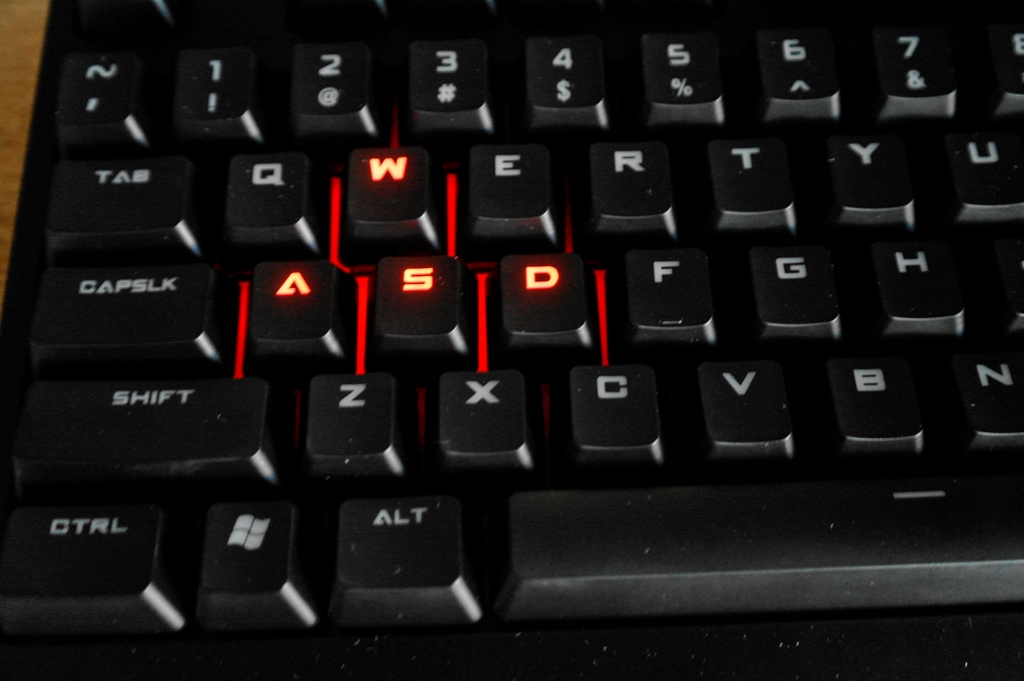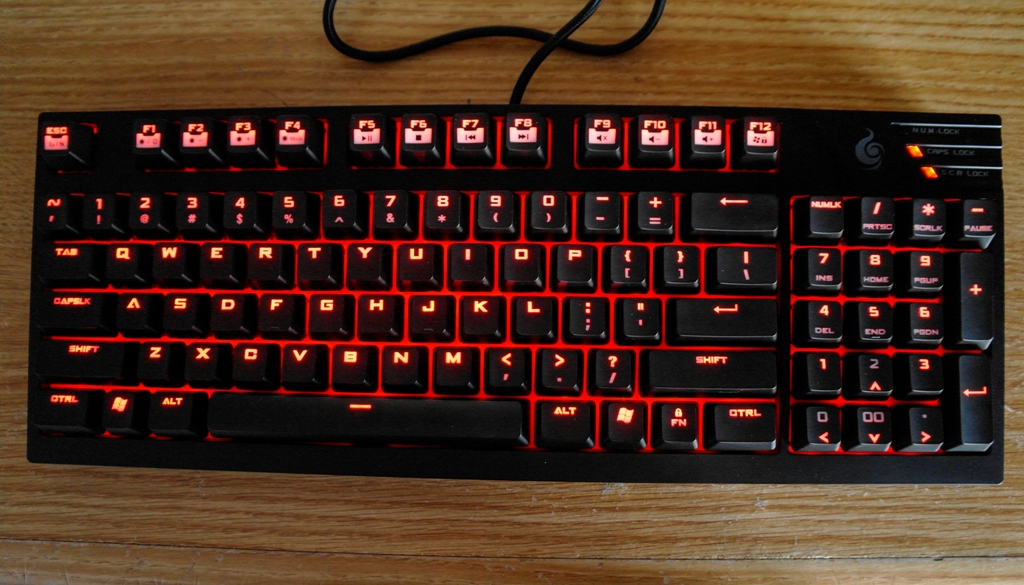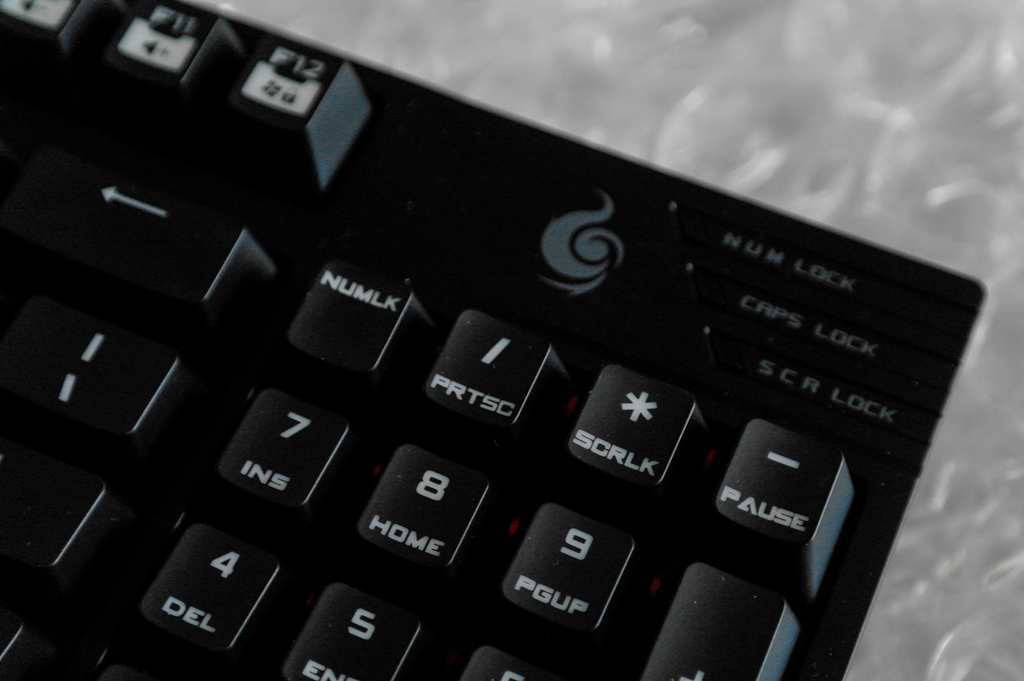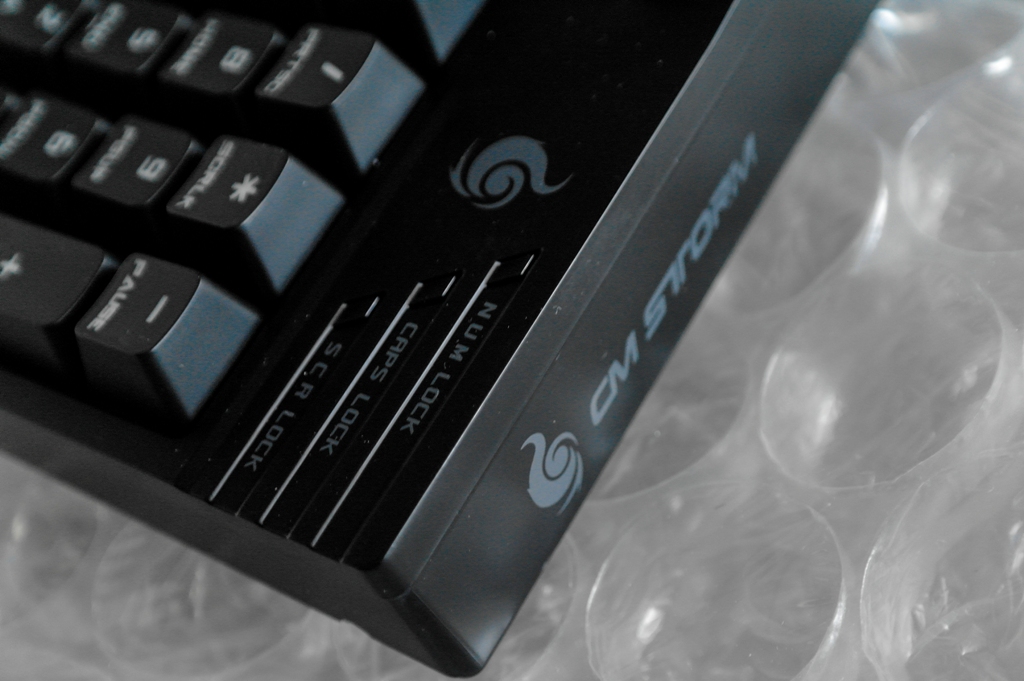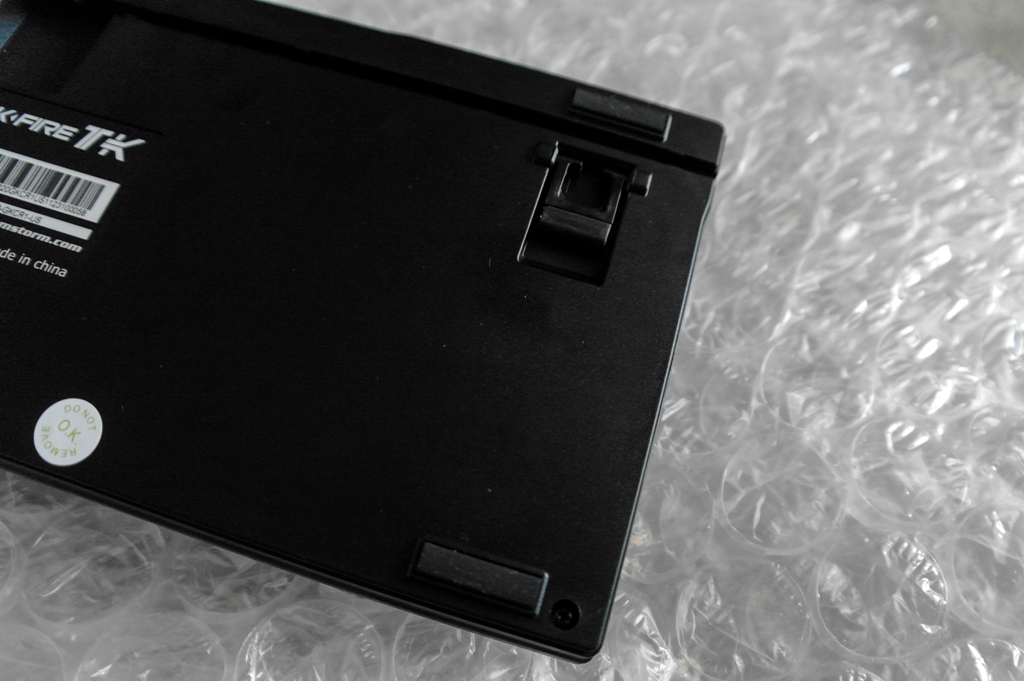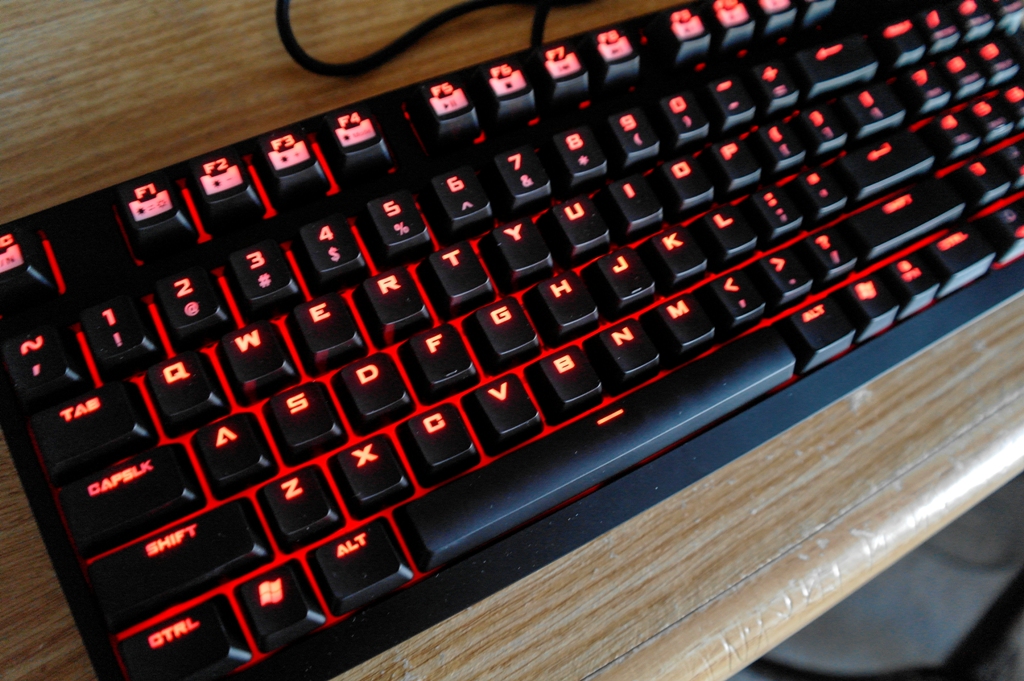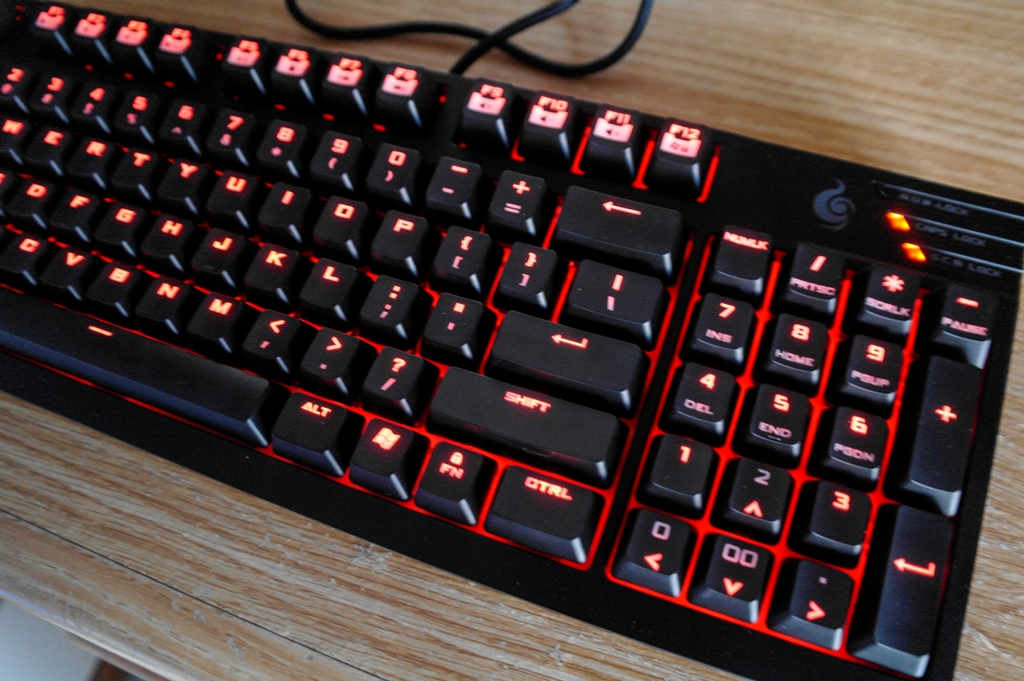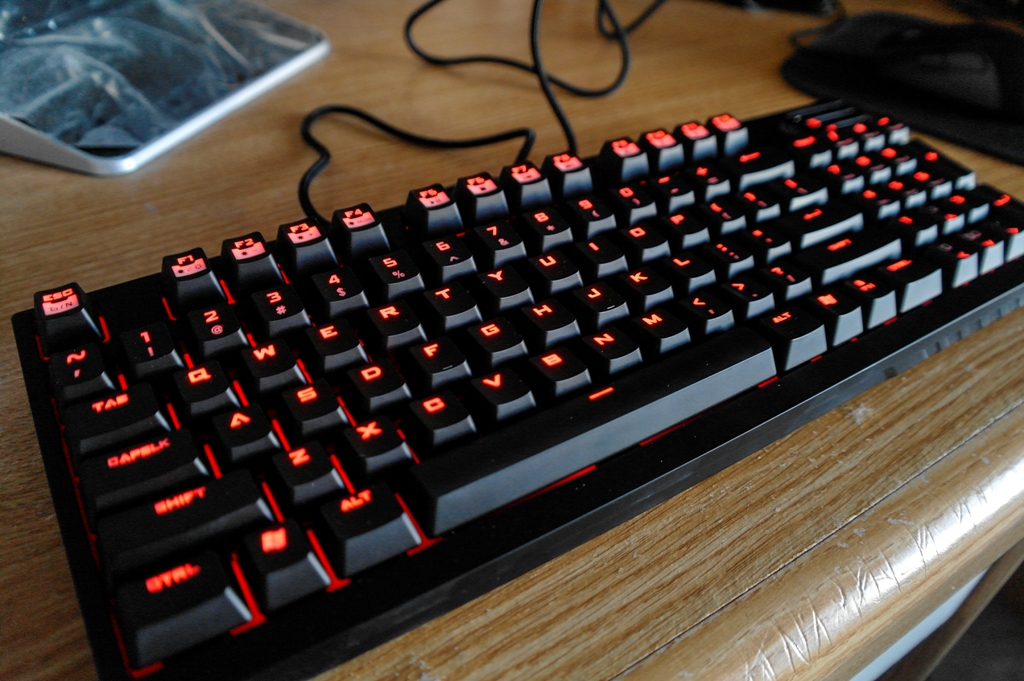The modes of configuration are fairly comprehensive, but I will try and sum them up. The ESC key acts as a double N key, while the F1-F4 keys are used to change modes. You can have all keys lit; only the WASD keys, only the navigation keys, both of them, or none at all.
The F5-F12 keys constitute the media functions, such as play, stop, forward and back to name a few. The F12 includes a function that disables the Windows key during gaming to prevent window minimization.
To the right of the F12 key resides the NUM, CAPS, and SCROLL lock indicator panel that lights red when those particular functions are in use:
On the panel and throughout the entire keyboard resides the patented Cooler Master Storm logo which unfortunately does not light-up as I had wished. Of course, you will not need to see that in dark conditions, but it would have been a nice touch.
After all of this, what you end up with is a sleek, condensed, yet feature-packed mechanical keyboard. Compared to my Logitech G15 and old Verbatim keyboard, the QuickFire TK takes up roughly 25-30% less space on the desk. It cuts off that unneeded excess space and tightens up, and the real-estate you save with it will certainly be a deciding factor for many users and gamers alike.
WHY SWITCH TO MECHANICAL?
Mechanical keyboards are no new concept. The earlier IBM keyboards were mechanical, but as time wore on membrane keyboards became the norm due to the cheap cost in material and production. The irony is that mechanical keyboards are better in every aspect compared to membrane, and although being older and rarer technology, cost more than membranous keyboards.
Feature-for-feature, mechanical keyboards win over membrane, especially considering switches. Having individual mechanisms for each component key instead of everything bound to a squishy membrane is quite a big difference.
Different styles of switches based on your preferences is also a key difference; Cherry MX Red, Brown, or Blue – regardless of what you pick they will be better than any membrane keyboard mechanism. Simply put, these switches are extremely durable, and made to increase the longevity and survivability of your keyboard up to millions of clicks. You also have the added benefit of being able to clean and remove every key independently.
The problem ultimately lies in pricing and how much a company can pack into a mechanical keyboard without increasing costs. $100 for the Cooler Master QuickFire TK is, in all honesty, quite cheap for a mechanical keyboard considering that you literally get everything a full-sized keyboard has in a small design.
However, there are other things to consider. My Logitech G15 for example has an LCD screen, USB ports, a palm rest, extra G buttons and media buttons, and separate navigation and functionality keys (such as sleep mode), as well as its own numpad…all for roughly $70. If these are important to you, it is something to consider before purchasing a mechanical keyboard because extra additions like these are rarely ever found on mechanical builds.
Furthermore, you have the learning curve. In terms of the QuickFire TK, you will have to learn the new layout and switch between modes in order to use everything it offers, especially coming from a full-sized keyboard like the G15. In addition, you will also have to learn how to utilize the switches properly in order to prevent extra button presses.
The final note to consider is sound. Mechanical switches are extremely loud, and you will notice this coming from a membrane keyboard. The sound difference is like night and day, so if you prefer to be in complete silence when you work or game, remember that typing on the QuickFire TK (and any other mechanical keyboard) will sound like a tap-dancing festival.
With all that said, if you have the choice and the budget, definitely go for a mechanical keyboard. The switch technology is too good to let up. Just temper expectations that finding a full-featured keyboard like the QuickFire TK is not an easy task, especially if you’re looking for extra incentives.
FINAL WORDS AND CONCLUSION
I am extremely impressed overall with Cooler Master ‘s QuickFire TK. They took the designs of the Rapid and Pro and joined them together to form the TK while still retaining a compact form-factor. When it comes to keyboards, gamers are extremely picky (including myself). I can safely say that the QuickFire TK has exceeded my expectations, and has propelled my skill higher than the G15 ever could.
There is not much that I can say negatively about the QuickFire TK. As a review sample it is missing documentation which I would have loved to use for figuring out the different modes of operation. Extra replaceable keys would have been nice as well, including custom Cooler Master Storm software. Having the Storm logos light up would have been a great touch to the black and red scheme. As a note, keep in mind that you may have to relearn your keyboard mentality; trust me when I say that the experience that comes after the refresh will be worth it.
Ultimately, there is nothing more than I can add that I have not said already. The QuickFire TK is compact, customizable, comfortable, aesthetically pleasing, durable, and built for longevity. Simply put, it is a refined, portable, solidly well-built keyboard made for gamers in mind, and at a decent price-point to boot. There is no question that the engineers at Cooler Master put a lot of thought into making it and it shows. Certainly for myself, it has overtaken my G15 for gaming sessions, and if you are in the market, heavily consider the QuickFire TK because it certainly is a smart investment that will last you well into your gaming career.
Check Out Cooler Master Storm Quickfire TK Keyboards at Amazon!
 Technology X Tomorrow's Technology Today!
Technology X Tomorrow's Technology Today!

